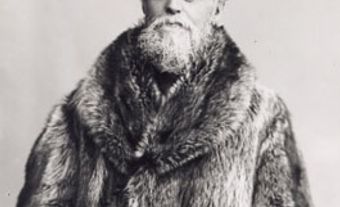George Frederic Matthew
George Frederic Matthew, customs officer, geologist, palaeontologist, (b at Saint John, NB 12 Aug 1837; d at Hastings-on-Hudson, NY 14 Apr 1923). Matthew attended Saint John Grammar School, but in his early years was largely self-educated as a geologist. He was influenced by Abraham GESNER's pioneering geological survey work in New Brunswick from 1838-1842, and Gesner's Museum opened in Saint John in 1842.Matthew was a founding member of the Steinhammer Club (1857-1862) formed to study the GEOLOGY and PALAEONTOLOGY around Saint John. J.W. DAWSON encouraged the club to create the Natural History Society of New Brunswick in 1862 where Matthew would spend his geological career, largely as an "amateur." Until 1919 Matthew served multiple roles as the Society's curator, librarian, president and leading geologist and palaeontologist. Stonehammer Geopark, North America's first member of the Global Geoparks Network, is named for the Steinhammer Club and features many of Matthew's geological sites.
Loring Woart BAILEY of the University of New Brunswick began geological mapping of New Brunswick with the assistance of Matthew and Charles Frederick Hartt. When the GEOLOGICAL SURVEY OF CANADA extended its work to the Maritime Provinces after Confederation, Director William Edmond LOGAN met with Bailey and Matthew to discuss further work. From 1864 to 1880 Matthew, Bailey and GSC geologist Robert Wheelock Ells, published numerous reports and maps on New Brunswick geology.
As a Government of Canada employee in the Custom's House, Matthew was occasionally seconded to work for the Geological Survey of Canada as a temporary geologist and was considered their Cambrian fossil expert. He was among the first to describe FOSSILS from the Stephen Formation in British Columbia that contains the BURGESS SHALE biota and he examined fossils from Cape Breton Island and Newfoundland for the Survey.
Most of Matthew's work was done near his home in Saint John. In 1863 Matthew, Bailey and Hartt travelled to Ratcliffe Brook where they discovered the first Cambrian TRILOBITES in Canada. J.W. Dawson included the work in his second edition of Acadian Geology. Although Matthew's early interest was in geological mapping and minerals he developed an interest in fossils after the departure of Hartt from the Natural History Society. Matthew studied the Cambrian fauna of the Saint John Group, publishing many of his classic papers in the Transactions of the ROYAL SOCIETY OF CANADA. In 1888 he published a description of Paradoxides regina, then the largest known trilobite, found by his young son William Diller Matthew. His work included some of the earliest recognition of an assemblage of "small shelly fossils" older than trilobites. His work on the Early Cambrian brought him into a friendly conflict with Charles Doolittle Walcott, the American Cambrian expert and later Director of the United States Geological Survey.
Matthew described Carboniferous plant and ARTHROPOD fossils from the famous Fern Ledges site discovered in Saint John by the Steinhammer Club. He pioneered the classification of Carboniferous tetrapod trackways studying fossils from the JOGGINS CLIFFS, Nova Scotia and New Brunswick. Perhaps Matthew's least known, yet most significant achievement, was his 1890 description of Archaeozoon acadiense published in the Bulletin of the Natural History Society of New Brunswick. This stromatolite from Saint John is the world's first scientifically described Precambrian fossil. Matthew was well aware of the search for Precambrian fossils and Dawson's previous description of the pseudofossil Eozoon canadense.
Matthew was a Charter member of the Royal Society of Canada founded in 1882. The Université Laval conferred a DSc on him in 1894. He received two honorary degrees from the University of New Brunswick, an MA in 1878 and LLD in 1897. In 1917 Matthew was awarded the Murchison Medal by the Geological Society of London. Matthew wrote more than 200 papers about geology and fossils. His specimen collections and letters are found at the New Brunswick Museum and the ROYAL ONTARIO MUSEUM.

 Share on Facebook
Share on Facebook Share on X
Share on X Share by Email
Share by Email Share on Google Classroom
Share on Google Classroom

